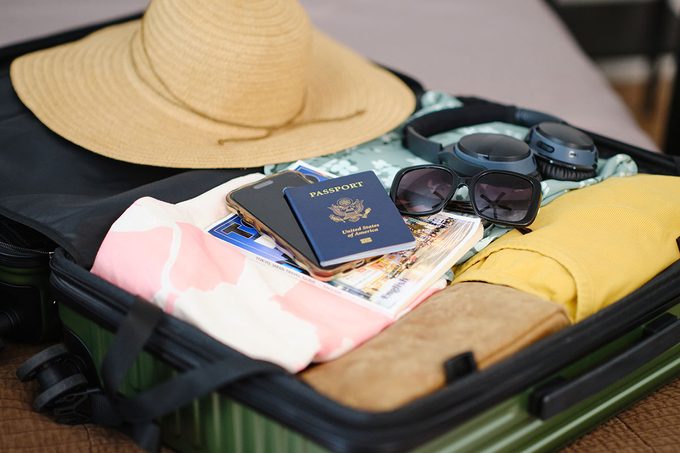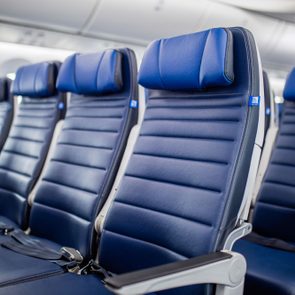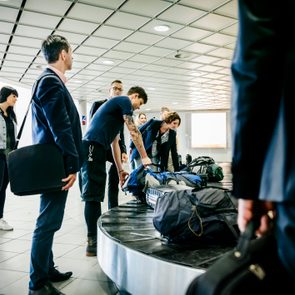It's a travel mistake you won't want to make

Here’s Why You Should Never Put Your Passport in Your Carry-on

We all have our go-to passport hiding spots—tucked in a hotel safe, buried in a jacket pocket or hidden deep in a personal bag to go under the airplane seat. And if you’re anything like me, the thought of parting with your passport makes your stomach twist. I’ve always kept mine close.
But recently, I learned about a hiding spot we all should be avoiding at all costs: your carry-on. Yep. That bag you guard with your life? It might be the worst possible spot. And once you find out why, you might just rethink your entire packing strategy.
So before you zip your bag and head to the airport thinking you’ve got it all figured out, read on. We’re breaking down the risks, the travel scenarios no one warns you about—and most importantly—what you should do instead to keep your passport secure, accessible and exactly where it needs to be when it matters most.
Get Reader’s Digest’s Read Up newsletter for more travel, humor, tech, cleaning and fun facts all week long.
Why shouldn’t you put your passport in your carry-on?
If you’ve been considering putting your passport in your carry-on, here are some reasons why you should avoid doing so, no matter how convenient it may seem.
Carry-on theft
Just because your bag is close doesn’t mean it’s safe. Carry-on theft is on the rise, especially on international flights and at crowded gates. According to the aviation technology company SITA, there were 33.4 million mishandled bags globally in 2024. From that number, roughly 2.67 million were lost or stolen. Some thieves specifically target overhead bins, knowing people rarely check their bags mid-flight. Plus, there have been multiple instances where there’s no space in the overhead bin by my seat, so my carry-on would have to move to the back or front of the plane. And if your carry-on looks like someone else’s, someone might even accidentally take it thinking it’s theirs.
“An acquaintance who travels infrequently had to gate check a bag on a flight prior to a cruise,” commented one Reddit user under a post on carry-on luggage thefts. “She didn’t realize she had the wrong bag until she was on the cruise ship.” Another Reddit user commented on how their wallet was stolen out of their bag in the overhead bin when they were flying by themselves at a young age. “Ever since then I NEVER put anything in the overhead bin that is easy to steal,” they commented. And a passport is definitely one of those important items you don’t want stuffed in your carry-on in the overhead lockers.
Gate check surprises
You board the plane thinking you’re good to go—then suddenly, airline staff announce there’s no more overhead space and ask passengers to gate check their bags. It happens all the time, especially on full flights. If your passport is in your carry-on and you’re forced to check it last minute, you could be separated from your most important document without warning.
Issues with immigration and customs
Especially during international travel, you’ll need your passport multiple times—often before you even board the plane, again upon landing and during customs screening. If your carry-on is stored in an overhead bin (or worse, gate-checked), you may not be able to access your passport when needed. That delay can slow you down, cause confusion or even result in being pulled aside by immigration.
Emergency situations
If you’re suddenly asked to evacuate a plane, respond to an emergency, or move quickly through an airport, there won’t be time to grab your overhead bag. Having your passport on you—not in your carry-on—ensures you’re not left behind, stuck, or unable to prove your identity in critical moments.
Layovers and flight changes
Tight connections, last-minute gate changes or delays that lead to rebookings can force you to move fast through terminals or even re-clear security. In those moments, if your passport is trapped in a carry-on that’s been checked or is across the cabin, you’re left scrambling. Worse, you might miss your next flight or be denied entry at your layover destination.
Where should you put your passport instead?

Instead of stashing your passport in your carry-on, here are five smart and secure places to store it while traveling.
- On-body travel wallet or neck pouch: These are designed specifically for passports and other essentials. Worn under your clothes, they make it extremely difficult for pickpockets to access. It’s even better that they’re always on you.
- Money belt: Similar to a neck pouch, a money belt keeps your passport flat and hidden around your waist. It’s ideal if you want to stay hands-free while keeping your passport literally on you at all times.
- Zippered inner jacket pocket: A secure, zippered inner jacket pocket (not the outer ones) gives you easy access while still keeping your passport safe and close. It’s the perfect choice for travelers annoyed with digging through their bags.
Wait—isn’t a pocket a bad idea?
Luckily, not all pockets are created equally. Stuffing your passport in your back pocket or anywhere unzipped is a passport mistake (and boarding pass mistake, too) you won’t want to commit. Instead, opt for an internal, zippered pocket—ideally one that’s close to your body.
Where else shouldn’t you put your passport?
Other than avoiding your carry-on bag, there are several other places where you shouldn’t put your passport while traveling. Here’s where to avoid.
- Your back pocket: It’s one of the easiest spots for pickpockets to target—especially in crowded tourist areas, train stations or airports. Plus, it can slip out without you noticing.
- The outer pocket of a bag: These pockets are often unzipped or only lightly secured. They’re the perfect targets for thieves, especially if you’re wearing a backpack.
- Checked luggage: If your bag gets lost, delayed or mishandled before reaching baggage claim, your passport goes with it—and that could leave you stranded.
- Unused jacket: You might take your jacket off in a rush, toss it on a chair or store it in an overhead bin—accidentally separating yourself from your passport.
- Personal bag: That’s right—even the bag you put under your seat can be a mistake. One TikToker, Ryan Crouse, recently shared a jaw-dropping travel nightmare. During a layover in Shanghai, China, he accidentally left his bag under the seat in front of him after deplaning. In the few short minutes it took for him to realize and return to retrieve it, the bag—and everything inside it—was gone. His passport, wallet, credit cards and every form of ID had vanished.
What should you do if you’re separated from your passport?
If you’ve been a victim of carry-on theft, with your beloved passport stuck inside, don’t fret. Here’s what to do if you’re separated from your passport while traveling.
- Retrace your steps: Check your hotel, bag, jacket and airport lost & found. There’s a chance you lost it, instead of it being stolen.
- File a police report: If it’s gone for good, report it. You’ll need this to get a replacement or emergency passport.
- Contact your embassy or consulate: Officials can help you get a temporary passport to finish your trip or get home.
- Gather backup information: Bring any ID, travel docs and especially a photo or digital copy of your lost passport.
- Apply for a new passport: Once you’re home, renew or replace your passport officially to avoid future travel issues. According to the U.S. Department of State, you can report your lost or stolen passport online, by mail or in person when you apply for a new passport. And if it was stolen, keep an eye on your bank accounts and let them know of any suspicious charges.
RELATED:
- Flying Solo Just Got More Expensive—Here’s How to Avoid Paying Extra
- This Is the Best Seat to Book on an Airplane to Avoid Motion Sickness, According to a Flight Attendant
- Here’s Why You Should Always Screenshot This Important Travel Document Before a Flight
Why trust us
Reader’s Digest has published hundreds of travel stories that help readers explore the world safely, easily and affordably. We regularly cover topics such as the best places to visit (and the best times to visit them), tips and tricks to zoom through airport security, flight-attendant secrets, hotel-room hacks and more. We’re committed to producing high-quality content by writers with expertise and experience in their field in consultation with relevant, qualified experts. We rely on reputable primary sources, including government and professional organizations and academic institutions as well as our writers’ personal experiences where appropriate. We verify all facts and data, back them with credible sourcing and revisit them over time to ensure they remain accurate and up to date. Read more about our team, our contributors and our editorial policies.
Sources:
- Reddit: “Carry on luggage thefts”
- U.S. Department of State: “Report my Passport Lost or Stolen”
- TikTok: @ryancrouse
- Valor International: “Airline industry reports decline in lost luggage in 2024”



